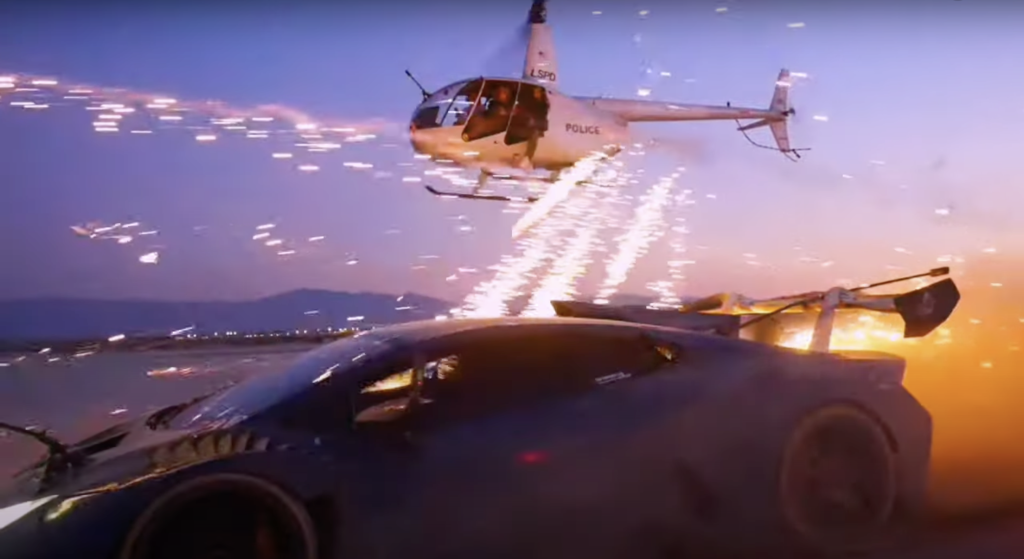Shooting fireworks out of a helicopter sounds fun. Shooting fireworks out of a helicopter at a Lamborghini sports car sounds really fun, especially if everyone on the helicopter and everyone in the Lamborghini consents. Alex Choi, a YouTube and Instagram vlogger in California, produced a video of him and his crew doing just that. But he forgot to ask one important group for permission: the federal government.
Earlier this week, the feds indicted Choi for “causing the placement of explosive or incendiary device on an aircraft,” a crime with a maximum penalty of 10 years in prison. The indictment also revealed that the Federal Aviation Administration (FAA) had revoked the license from Choi’s helicopter pilot in January 2024 for flying less than 500 feet from people, failing to display the helicopter’s registration number, and creating “a hazard to persons or property” without the necessary FAA waivers.
By all accounts, the only danger was to people directly involved in the video, which has since been removed from Choi’s YouTube and Instagram accounts. (Clips of the stunt are still available elsewhere.) Choi and his crew filmed the stunt at El Mirage dry lake bed, an off-roading recreation area miles away from any town. The indictment quotes Choi talking about his “crazy stupid ideas” and one of his crew members saying that the fireworks are “so loud; it’s actually terrifying,” which only makes the video sound cooler.
The FAA moved very quickly when it caught wind of the stunt. Choi posted the video on the Fourth of July last year. On July 18, an FAA inspector interviewed the person who transported cars for Choi. A few days later, the FAA tracked down the helicopter pilot and a Bureau of Land Management agent went out to the dry lake to photograph Choi’s tire tracks. Since the lake bed is federal land, the indictment notes, Choi should have gotten federal permission.
Soon after the FAA interrogations began, Choi texted an associate that the FAA inspector “has a personal issue with my helicopter pilot friend and every time i do a shoot with him, tries to get more information about him so he can go after him,” according to the indictment.
The Department of Transportation’s Office of Inspector General then decided to charge Choi with a crime. The law against taking an explosive on board an aircraft clearly seems to be aimed at would-be bombers, but the feds argue that it applies to firing explosives out of an aircraft as well.
The case against Choi parallels the case of Austin Haughwout almost a decade ago. In 2015, when consumer drone technology was still in its infancy, the teenage Haughwout filmed himself flying a drone with a pistol attached and firing into the woods. The 14-second video, titled “Flying Gun,” caused a national media panic about the danger of armed drones. Haughwout also posted a video of himself roasting meat with a drone-mounted flamethrower.
The FAA subpoenaed Haughwout and his father because the videos showed potentially unsafe piloting of an aircraft. The Haughwout family fought the subpoena in court, arguing that drones are not “aircraft” within the FAA’s jurisdiction. (Their lawyer compared the situation to the FAA regulating baseballs, paper airplanes, or birthday balloons.) A district court ruled in favor of the subpoena, and although Haughwout was not charged with an aviation crime, the case became a key precedent for the FAA’s ability to regulate drones.
Since then, the FAA has scoured social media for potential drone violations. Earlier this year, a federal court banned Philadelphia YouTuber Michael DiCiurcio from flying drones and fined him $182,000 for violating FAA rules. DiCiurcio had gotten famous for making slapstick videos of himself fighting birds, buzzing fishermen, and crashing into himself with his drone, all while narrating in a thick South Philly accent.
Last year, aviation vlogger Joe Costanza had a friend follow his small Piper Cub airplane down a private runway with a drone. When Costanza posted the video to a Facebook group—and joked that “the pilot knew that the drone was there because I was flying both at the same time”—he was contacted by an FAA inspector. In the end, the FAA did not press any charges, but Constanza took to YouTube to complain about the investigation.
“You know, no matter how stupid the complaint is or how out of the ordinary it is, we have to investigate every single complaint that comes out way,” the inspector said, according to Constanza.
The post California YouTuber Faces 10 Years for Having Too Much Fun With Fireworks appeared first on Reason.com.






